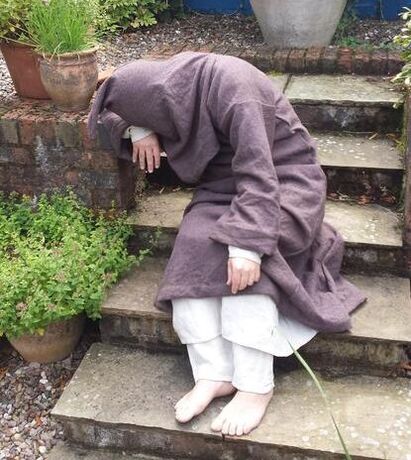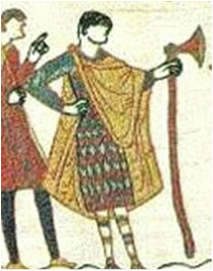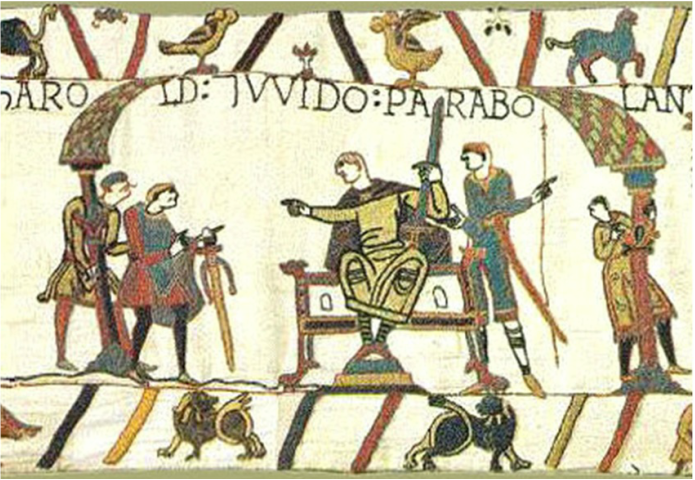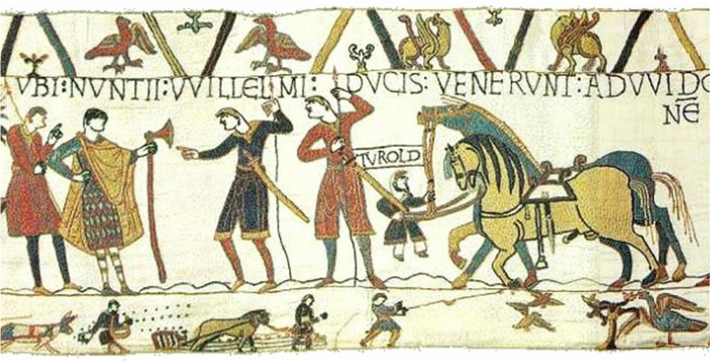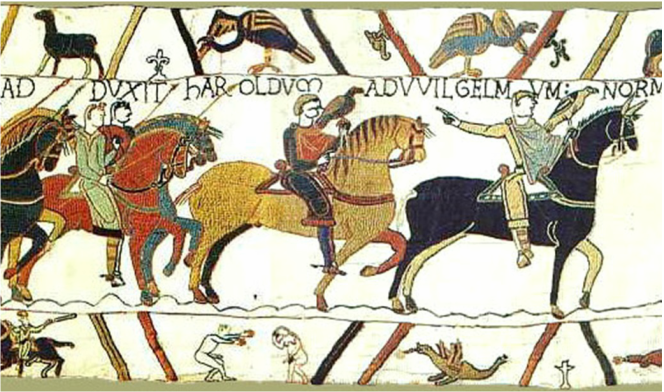The Anglo-Saxon Monk is entering the world of theatrical performance in a dramatisation of the Bayeux Tapestry written and directed by Daisy Black – please don’t tell the bishop! Curiously, I’ve been handed the role of the French count, Guy of Ponthieu. I assure you, blessed readers, I remonstrated most strongly with Dr Black over her casting decisions, but alas, one has to take what one can get. So who, you are wondering, was this Guy fellow, and why in the picture above, do I look such a ****? First things first. Guy, or Wido as he is named in the Tapestry, was born in the 1020s and in 1053 became count of Ponthieu which, in your twenty-first century, corresponds to an area within the region of Picardy in northern France. At the point he is depicted in the Tapestry, Guy is a vassal of Duke William of Normandy, the future conqueror of my beloved Anglo-Saxon England – 1066 and all that. William had previously captured Guy at the Battle of Mortemer, a squabble between William’s Normans and the allied forces of King Henry of France and the Ponthieuvins; and he had actually spent two years as a prisoner of William. In the Tapestry narrative, Guy is the fellow who has Earl Harold arrested when the unfortunate Englishman manages to get shipwrecked on Guy’s shores (some scholars doubt the veracity of this account). Harold, as you probably know, has been sent across the sea by his king, Edward the Confessor, to meet up with William, though the Tapestry doesn’t spell out why he was sent to Normandy. Guy’s wicked intention in capturing Harold, whom you see here brought before the count sitting on his throne, is to hold him to ransom – a common practice, apparently, in that area. William gets wind of this and sends his own men to demand the release of Harold. Guy has no choice but to oblige – William’s men are quite strapping, as you can see, and have big swords. Once Harold is escorted by Guy (and the two big Norman lads) to William, Harold ends up swearing an oath of loyalty to the duke and, as the story goes (well, it depends on whose side you stand), he promises to smoothly engineer William’s path to the English throne once heirless old Eddy pops his Anglo-Saxon footwear.  Visual joke: Note the ass in the border scene, and the farmer pointing up to Guy. The ass theme reoccurs a little later when Guy is shown riding a gelding (a castrated horse) with donkey's ears. Visual joke: Note the ass in the border scene, and the farmer pointing up to Guy. The ass theme reoccurs a little later when Guy is shown riding a gelding (a castrated horse) with donkey's ears. Harold eventually reneges, is crowned king himself on the earthly demise of Edward, and consequently William throws an almighty tantrum. You know the rest, beloved. So Guy of Ponthieu, a minor figure in history, can be seen – at least from the narrative of the Tapestry – as the catalyst in the overthrowing of Anglo-Saxon England by William. This may partly explain why the Tapestry, which most scholars believe was designed and produced in England, throws a few insults at him. Insults? Yes, blessed ones! Not only am I – I mean Guy – depicted holding my sword by the blade – what a numpty! – but, on my trip to hand over Harold to William, I am seated upon a gelding with donkey ears! And as for that moment just before, when those two big brutes announce Willy’s demands, I’m made to look like I’m singing the opening line to ‘I’m a little Teapot’! I may be a French coward, but let’s play nicely. According to my alter ego, Dr Monk, Guy’s hand-on-hip posture is actually one of masculine confrontation. He assures me that the juxtaposition of William’s weapon-wielding wannabes suggests just that. Point taken, I suppose. And, apparently, should we be in any doubt about the heightened testosterone levels at this juncture of the Tapestry narrative, the other Monk also informs me that we should just take a look at the two horses from which William’s men dismount. As you can see, Guy’s dwarf-groom can barely control the blue one (no, of course horses weren’t blue in the eleventh century!), and the other, if you look closely, has... well, how shall I put it?... a rather outward manifestation of male assertiveness. But, I tell you, blessed readers, Guy is being insulted here, even if that posture of his is not meant to be the campest thing in the Tapestry. Just look at how his bold masculinity is cleverly undercut in the border scene below. Notice the farmer pointing up to Guy? It just so happens that his plough is drawn not by an ox but by an ass. Yes, donkeys again! No wonder I was so upset when Dr Black gave me Guy to play! So how exactly do I explain the portrayal of Guy in my picture at the outset? What historically underpins such a performance? First, I must make it abundantly clear that I’m doing this for art’s sake. Next, that my motivation is not my delight in causing offence. And finally, most seriously, I must lay the blame at the feet of Professor Gale Owen-Crocker, who also happens to be acting in Dr Black’s drama (she gets to be a master English embroiderer!). You see, it’s her scholarship that has brought to our attention that the Bayeux Tapestry was not the only vehicle for undermining Guy. (It was Owen-Crocker who first spotted the donkey ears, by the way.) As she has observed more than once, the twelfth-century historian William of Malmesbury actually goes on record to report Harold’s own take on his captor: ‘Si pecuniis exuenda captiuitatas esset, libens daret Willelmo comiti, non semiuiro Guidone’, which very roughly translates as “There’s no way any ransom is being paid to that Nancy-boy!” Well, actually, Guy gets called a half-man, but you get the meaning of this gross insult from my own choice of idiom, I’m sure. And so there you have it, blessed ones. I almost feel sorry for Guy, remorselessly poked fun at and emasculated. Mind you, he does look good in that brunette wig, don’t you think? The Bayeux Tapestry: The Stitches Speak will be performed May 16, 3:30 p.m. at the 50th International Congress on Medieval Studies, Kalamazoo, Western Michigan University. Please note that all images from the Bayeux Tapestry are provided via Wikimedia Commons and are Public Domain in USA. This website is hosted by Weebly, a US-based company, and I therefore assert their Public Domain status on this website.
6 Comments
Chris *The Anglo-Saxon Monk
25/4/2015 06:07:06 pm
But he doesn't even manage to hold that as if he knows what he's doing :-)
Reply
30/4/2015 08:05:22 am
As I am playing the conquering William in this major theatrical event, I feel I should warn you, Guy, that if you ever call me Willie again I shall order my big Norman lads to twist your stripey socks around your Picardian neck. Just sayin'.
Reply
Chris/Anglo-Saxon Monk/Guy of Ponthieu
30/4/2015 08:56:00 am
Well now Will-i-am, keep that temper of yours in check. My humble, obsequious apologies. See you at the Zoo!
Reply
30/4/2015 09:10:56 am
Just...getting into the role, you know. See you there! Your comment will be posted after it is approved.
Leave a Reply. |
Details
|

